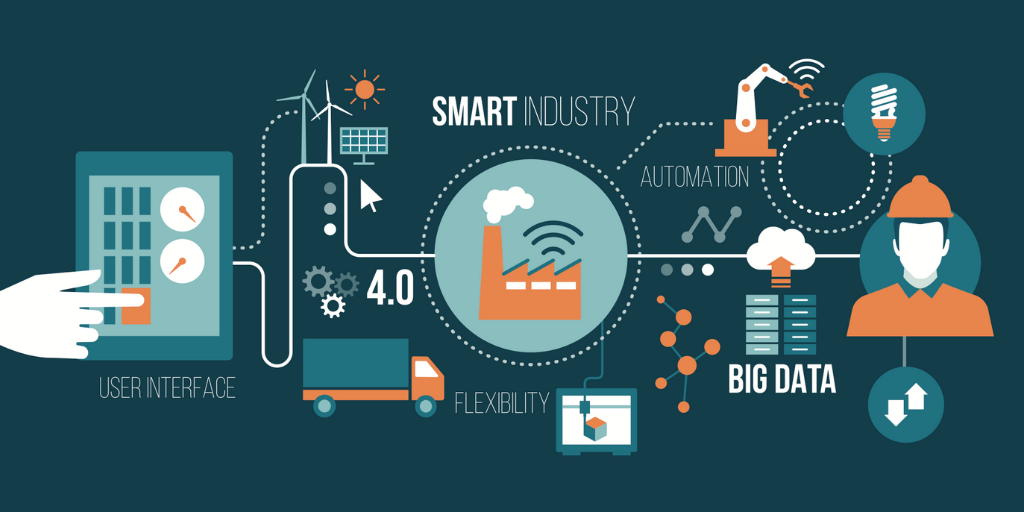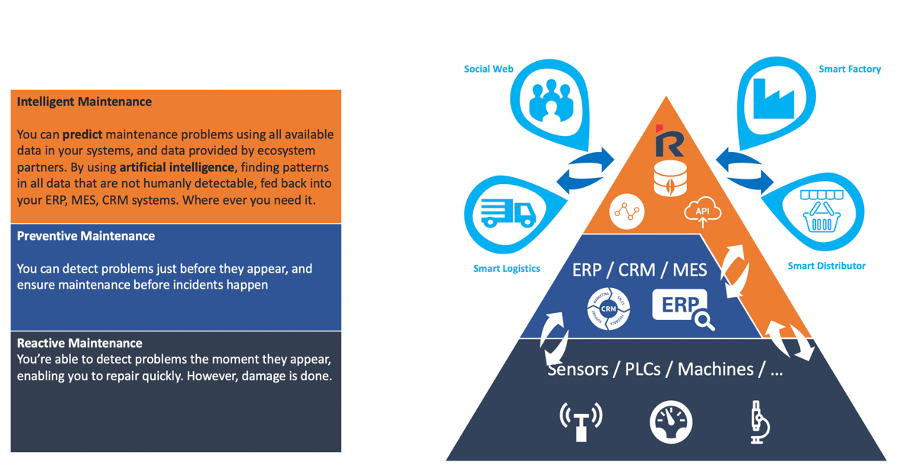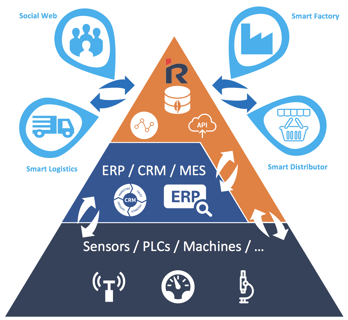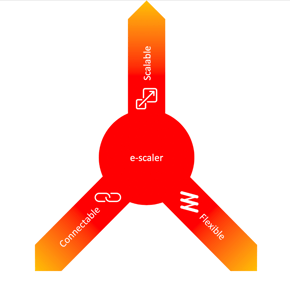
Despite the enthusiasm for the digital transformation to a digital manufacturing future, two out of three companies piloting digital manufacturing solutions fail to move into large-scale rollout (Industry Week). Our experience learned us there are 3 dimensions to consider in your journey:
- Business Dimension
- Technological Dimension
- Organisational Dimension
The technological dimension of course is the one considered in most cases. And it is the enabler to a smart factory indeed. However, fail to balance technological actions with a clear focus on business goals, or to embed this new technology into your organisation and the people working in it, and you’re guaranteed not to meet your goals.
Business Dimension
There are several reasons to invest in the future, to invest in building your smart factory. But in the end, they’re all business related. For clarity reasons, let’s dive into some examples.
Sustainable Development Goals
The United Nation’s Sustainable Development Goals are more and more the norm for companies in general, and manufacturer’s more specifically. Good health and well-being are becoming the norm for food producers. How can we produce food with less fat, less sugar, with extra vitamines, … but still ensure the quality they’re known for. In the process not only aiming for the same competitive price point, but maybe striving for a better, competitive edge.

Climate Action requires all manufacturers to produce less CO2 emissions. Maybe you can optimise your warehouses by minimising the number of movements of goods beween different facilities, reducing the CO2 emissions generated by transports. Just a suggestion.
Predictive or Intelligent Maintenance
Some production lines are highly automated, fully supported by the suppliers of these systems. They will predict when parts need to be replaced, allowing you to do maintenance in the most optimal moment. However, in many cases, supplier machines are only one part of a complete production line, and you need to combine information of all parts. Maybe you still have older production lines, not fully automated and monitored by the supplier’s software. Or your engineers may have developed your own production lines, specifically tailored to your products, giving you that competitive edge. Predictive maintenance requires all these components to monitored. Intelligent maintenance requires to combine information generated by all components and possibly external information generated by your ecosystem partners, discovering patterns not humanly detectable.
Let’s take this one step further. What if I tell you we can use the same technology to predict upcoming production problems, to intelligently connect customer feedback to production data and prevent bad feedback. Just imagine!
Optimise Use of Raw Materials
You may have different suppliers of raw materials, for several reasons. Maybe this enables you to reduce cost, maximising margins. Maybe there’s not one supplier that can deliver the appropriate amount of materials for your scaling business. Each of these raw materials exposing different quality attributes, requiring changes in your production process to guarantee the same quality of the end product. Again, you need to combine information from different sources and add intelligence to cope with such complex problems.
Start Small, Think Big
It is nearly impossible to tackle all these challenges simultaneously. You want to tackle them according to priorities. But in a flexible way. If there’s one thing we take away from the current Covid-19 crisis, it’s that priorities and context may change overnight. If we really want to prepare for the future, our companies must become digital (data-based, inter-connected). We need to build agility, flexibility and scalability into our factories. Our factories need to become smart and adaptable, where technology and humans strengthen each other in producing the best products for our customers.
Technology Dimension
Technology, when applied in a smart way, needs to be an enabler to reach the business goals of your company. We are not implementing technology for the sake of technology. If we read through the above examples, we can deduce some of the properties of the technology we require.
Full Connectivity, Interoperability
When sifting through the above business goals, one thing becomes very obvious. Data needs to flow between all systems in and outside of our company. There is not one system that offers all this functionality. We want to maximise the existing products we have in place to use their functionality to our maximal gain. But we also need to glue all systems together, to ensure insights above and beyond. And we need to add an intelligent layer. Because today, we may be data-rich, we are still insight-poor.

Prepare for growth
Our journey will start small. Highest, achievable goals first. But once we get the taste of this journey, we’ll want more. We will see new potential optimisations, new possibilities with the data we have at hand, and the intelligence we add on top. So, whatever solutions we choose, they need to be scalable, flexible and connectable. This is what we call an e-scaler. We’ll dive into this topic in our next blog post.

More than just ‘Off the Shelf’
Yes, there is a lot of functionality you can buy off the shelf. And you should do so. You should maximise what you can do with off the shelf products. But you’re unique, competitive advantage is not off the shelf, the products you make are specific. They require specific machines or production lines, they require specific conditions. As a result, they require technology that combines the strength of off the shelf products with functionality and intelligence built specifically for you. And when it comes to this differentiating edge, you have several options. You build it all yourself if you have the people and the means to do so. You ask a supplier to build it for you, risking vendor lock-in. Or you go for a hybrid approach: you choose a supplier to deliver an open, digital platform. And start building business value on top of it, leaving you in charge. We’ll explore this last option in a next blog post.
Organisational Dimension
A digital transformation like this, your journey to a smart factory, has an important organisational component. This is often forgotten, resulting in a huge investment not delivering on business value.
Technological Skill Gap
The technological skills required to build a Digital Platform as described in the above section, are in many cases not the same as the technical skills required to operate your factory. Indeed, to ensure fluidisation of data in your company, you require additional skills on unlocking and capturing data from several systems in a dynamic and sustainable way. Data engineering skills are required to ensure quality of data, to ensure we can trust the data (and thus trust the resulting algorithms). Data science skills and by extension, AI skills, are required to grow from an insight-poor company to an insight-rich company.
And finally, integration skills are required to communicate with both internal as external (e.g. supplier) systems. Integration skills are required to feed insights back into your operational systems, making the gained insights actionable.
It is very difficult to find people with all required skills, let alone to keep them.
Generation Gap
When talking to manufacturers, we’ve detected two problems. Older, very focussed and experienced operators leave the company, with inevitable knowledge drain. This may result in loss of quality, stability and productivity. Younger employees require more diversification in their jobs. Resulting in broader but less in-depth knowledge.
We need to invest in our operators of tomorrow, and maybe take this change as an opportunity. We need to invest in the operators of tomorrow working hand in hand with smart algorithms, as a smart factory will always be a hybrid of man and machine.
Multi-disciplinary
As mentioned before, building a smart factory requires internal and external data to flow in your organisation. To build smart algorithms, we require people with different skills. Our operators, shop floor managers, customer engagement managers, Supplier managers, digital marketeers, sales, IT need to join forces and add the smart in your data.
Conclusion
Studies show that manufacturing companies can save 10-40 % in maintenance costs, reduce downtime with 50% as well as extend the lifetime of the equipment with 3-5%. Despite the promising returns often the ROI is not realised. Successful digital transformations consider 3 dimensions. A balance is required between the business, technological and organisational aspects. Define your business priorities, but ensure flexibility. If you choose technological solutions, ensure they’re scalable, flexible and connectable. And ensure you’ve got the right people onboard over all disciplines necessary to achieve your goals.
But above all: start with a holistic view and vision, but move ahead in a pragmatic step by step approach. Welcome to industry 4.0.




.png?width=66&name=Pieter%20Laroy%20(2).png)

.png?width=300&name=Blogvisuals%20(6).png)

